Agricultural Eco-Efficiency Response and Its Influencing Factors from the Perspective of Rural Population Outflowing: A Case Study in Qinan County, China
Abstract
1. Introduction
2. Literature Review
3. Overview of the Study Area and Data Sources
3.1. Overview of the Study Area
3.1.1. Natural Geographical Overview
3.1.2. Overview of Socio-Economic
3.2. Data Sources
4. Method
4.1. The Super-SBM Model
4.2. Spatial Econometric Models
4.3. Variable Selection
4.3.1. Input-Output Indicator
4.3.2. Influential Factor Indicators
5. Results and Discussion
5.1. The Changing of Rural Population with Population Outflow
5.2. Temporal and Spatial Evolution Characteristics of Agricultural Eco-Efficiency under Population Outflow
5.2.1. Time Evolution Characteristics of Agricultural Eco-Efficiency
5.2.2. The Spatial Distribution of Agricultural Eco-Efficiency
5.3. Spillover Effect of Influencing Factors under Population Outflow
5.3.1. Spatial Autocorrelation Test
5.3.2. The Spatial Panel Econometric Model Test
5.3.3. Effect Decomposition
5.4. Discussion
5.4.1. The Influence Mechanism of the Driving Factor
- (1)
- Direct effect
- (2)
- The spatial spillover effect
5.4.2. Policy
- (1)
- Encourage rural labor to return home and optimize the labor structure.
- (2)
- Optimize the allocation of resource elements and strengthen agricultural ecological awareness.
- (3)
- Improve the allocation of financial support to agriculture and increase input in agricultural research and development.
5.4.3. Limitations
6. Conclusions
Author Contributions
Funding
Institutional Review Board Statement
Informed Consent Statement
Data Availability Statement
Acknowledgments
Conflicts of Interest
References
- Huang, X.; Xu, X.; Wang, Q.; Zhang, L.; Gao, X.; Chen, L. Assessment of agricultural carbon emissions and their spatiotemporal changes in China, 1997–2016. Int. J. Environ. Res. Publ. Health 2019, 16, 3105. [Google Scholar] [CrossRef] [PubMed]
- Ministry of Agriculture; National Development and Reform Commission; Ministry of Science and Technology. National Agricultural Sustainable Development Plan (2015–2030). Available online: http://www.moa.gov.cn/sjzz/jgs/cfc/yw/201505/t20150528_4620635.htm (accessed on 28 May 2015).
- Nie, W.; Yu, F.W. Research progress analysis of agricultural ecological efficiency. Chin. J. Eco-Agric. 2017, 25, 1371–1380. [Google Scholar]
- Rao, J.; Xu, X.; Ji, X. Research on current situation, occurrence mechanism and Countermeasures of agricultural non-point source pollution in China. Agric. Econ. Issues 2011, 8, 81–87. [Google Scholar]
- Guo, Y.; Zhou, Y.; Liu, Y. Spatial and temporal evolution of rural population outflow in China and its driving mechanism. Geogr. Sci. 2020, 40, 50–59. [Google Scholar]
- Yang, H.; Wang, X.; Peng, B. Agriculture carbon-emission reduction and changing factors behind agricultural eco-efficiency growth in China. J. Clean. Prod. 2021, 334, 130193. [Google Scholar] [CrossRef]
- Hou, M.; Yao, S. Spatial spillover effect and threshold characteristics of the impact of China’s rural labor transfer level on agricultural ecological efficiency. Resour. Sci. 2018, 40, 2475–2486. [Google Scholar]
- Zhang, Z.; Liao, X.; Li, C.; Yang, C.; Yang, S.; Li, Y. Spatial and temporal characteristics of county agricultural ecological efficiency in Hunan Province and its influencing factors. Econ. Geogr. 2022, 42, 181–189. [Google Scholar]
- Stępień, S.; Czyżewski, B.; Sapa, A.; Borychowski, M.; Poczta, W.; Poczta-Wajda, A. Eco-efficiency of small-scale farming in Poland and its institutional drivers. J. Clean. Prod. 2021, 279, 123721. [Google Scholar] [CrossRef]
- Todorovic, M.; Mehmeti, A.; Scardigno, A. Eco-efficiency of agricultural water systems: Methodological approach and assessment at meso-level scale. J. Environ. Manag. 2016, 165, 62–71. [Google Scholar] [CrossRef]
- Heidenreich, A.; Grovermann, C.; Kadzere, I.; Egyir, I.S.; Muriuki, A.; Bandanaa, J.; Clottey, J.; Ndungu, J.; Blockeel, J.; Muller, A.; et al. Sustainable intensification pathways in Sub-Saharan Africa: Assessing eco-efficiency of smallholder perennial cash crop production. Agr. Syst. 2022, 195, 103304. [Google Scholar] [CrossRef]
- Grassauer, F.; Herndl, M.; Nemecek, T.; Fritz, C.; Guggenberger, T.; Steinwidder, A.; Zollitsch, W. Assessing and improving eco-efficiency of multifunctional dairy farming: The need to address farms’ diversity. J. Clean. Prod. 2022, 338, 130627. [Google Scholar] [CrossRef]
- Angelis-Dimakis, A.; Arampatzis, G.; Assimacopoulos, D. Systemic eco-efficiency assessment of meso-level water use systems. J. Clean. Prod. 2016, 138, 195–207. [Google Scholar] [CrossRef]
- Masuda, K. Measuring eco-efficiency of wheat production in Japan: A combined application of life cycle assessment and data envelopment analysis. J. Clean. Prod. 2016, 126, 373–381. [Google Scholar] [CrossRef]
- Liao, J.; Yu, C.; Feng, Z.; Zhao, H.; Wu, K.; Ma, X. Spatial differentiation characteristics and driving factors of agricultural eco-efficiency in Chinese provinces from the perspective of ecosystem services. J. Clean. Prod. 2021, 288, 125466. [Google Scholar] [CrossRef]
- Li, L.; Xu, W.X. Changes in agricultural ecological efficiency under the effect of rural population aging. J. South China Agric. Univ. Soc. Sci. Ed. 2021, 20, 14–29. [Google Scholar]
- Liang, Y.W.; Wang, B.H. Study on the spatial-temporal evolution and influencing factors of an agricultural ecological efficiency in the Bohai Rim region. Ecol. Econ. 2021, 37, 109–116. [Google Scholar]
- Cao, J.W.; Zeng, K. Research on agricultural ecological efficiency and influencing factors in the Yangtze River economic belt from the perspective of low carbon. Ecol. Econ. 2019, 35, 115–119, 127. [Google Scholar]
- Hou, M.Y.; Deng, Y.J.; Yao, S.B. Nonagricultural transfer of rural labor, fertilizer application intensity and agricultural ecological efficiency: Interaction and spatial spillover. Agric. Technol. Econ. 2021, 10, 79–94. [Google Scholar]
- Pan, D.; Ying, R.Y. Evaluation method and demonstration of agricultural eco-efficiency in China: Analysis of SBM model based on undesired output. Acta Ecol. Sin. 2013, 33, 3837–3845. [Google Scholar] [CrossRef]
- Coluccia, B.; Valente, D.; Fusco, G.; De Leo, F.; Porrini, D. Assessing agricultural eco-efficiency in Italian Regions. Ecol. Indic. 2020, 116, 106483. [Google Scholar] [CrossRef]
- Yang, B.; Zhang, Z.; Wu, H. Detection and attribution of changes in agricultural eco-efficiency within rapid urbanized areas: A case study in the Urban agglomeration in the middle Reaches of Yangtze River, China. Ecol. Indic. 2022, 144, 109533. [Google Scholar] [CrossRef]
- Ma, L.; Zhang, W.; Wu, S.; Shi, Z. Research on the Impact of Rural Population Structure Changes on the Net Carbon Sink of Agricultural Production-Take Huan County in the Loess Hilly Region of China as an Example. Front. Environ. Sci. 2022, 10, 911403. [Google Scholar] [CrossRef]
- Tone, K. A slacks-based measure of super-efficiency in data envelopment analysis. Eur. J. Oper. Res. 2002, 143, 32–41. [Google Scholar] [CrossRef]
- Anselin, L. Spatial econometrics: Methods and models. Stud. Oper. Reg. Sci. 1988, 85, 310–330. [Google Scholar]
- LeSage, J.P.; Robert, P.K. Introduction to Spatial Econometrics; CRC Press: London, UK, 2009. [Google Scholar]
- Liu, D.; Zhu, X.; Wang, Y. China’s agricultural green total factor productivity based on carbon emission: An analysis of evolution trend and influencing factors. J. Clean. Prod. 2021, 278, 123692. [Google Scholar] [CrossRef]
- Parman, J. Good schools make good neighbors: Human capital spillovers in early 20th century agriculture. Explor. Econ. Hist. 2012, 49, 316–334. [Google Scholar] [CrossRef]
- Elhorst, J.P. Matlab Software for Spatial Panels. Int. Reg. Sci. Rev. 2014, 37, 389–405. [Google Scholar] [CrossRef]
- Lesage, J.P. An introduction to spatial econometrics. Rev. D’Économie Ind. 2008, 123, 19–44. [Google Scholar] [CrossRef]
- Liu, Y.; Zou, L.; Wang, Y. Spatial-temporal characteristics and influencing factors of agricultural eco-efficiency in China in recent 40 years. Land Use Policy 2020, 97, 104794. [Google Scholar] [CrossRef]
- Zhao, J.; Dang, G.; Tang, X. Study on the spatial-temporal difference and influencing factors of agricultural ecological efficiency in China based on SBM Tobit model. J. Southwest For. Univ. Soc. Sci. 2022, 6, 10–18. [Google Scholar]
- Wu, G.; Riaz, N.; Dong, R. China’s agricultural ecological efficiency and spatial spillover effect. Env. Dev Sustain. 2022. [Google Scholar] [CrossRef]
- Long, X.; Luo, Y.; Sun, H.; Tian, G. Fertilizer using intensity and environmental efficiency for China’s agriculture sector from 1997 to 2014. Nat. Hazards 2018, 92, 1573–1591. [Google Scholar] [CrossRef]
- Xiang, H.; Wang, Y.H.; Huang, Q.Q.; Yang, Q.Y. How Much Is the Eco-Efficiency of Agricultural Production in West China? Evidence from the Village Level Data. Int. J. Env. Res. Pub. Health 2020, 17, 4049. [Google Scholar] [CrossRef] [PubMed]


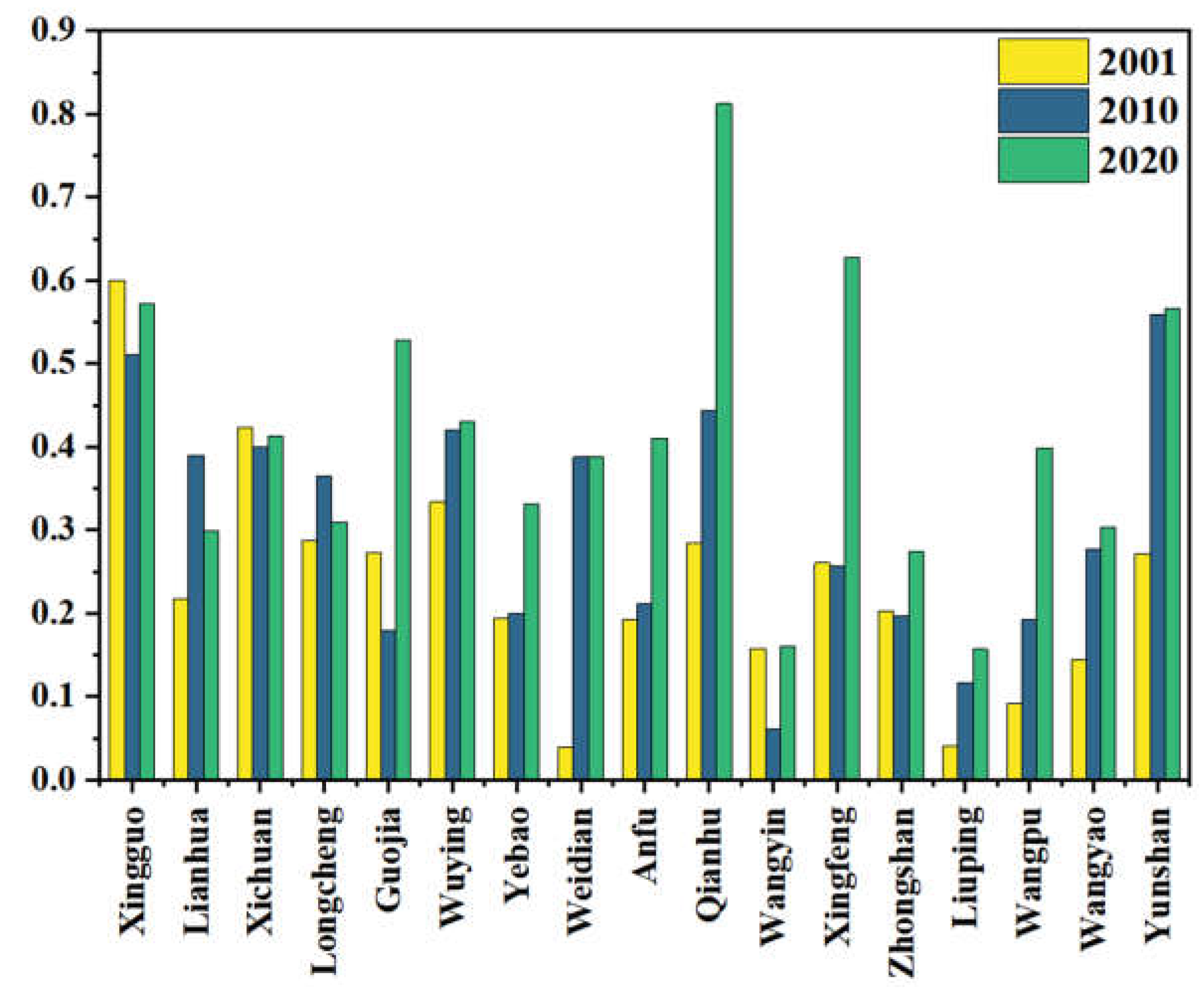
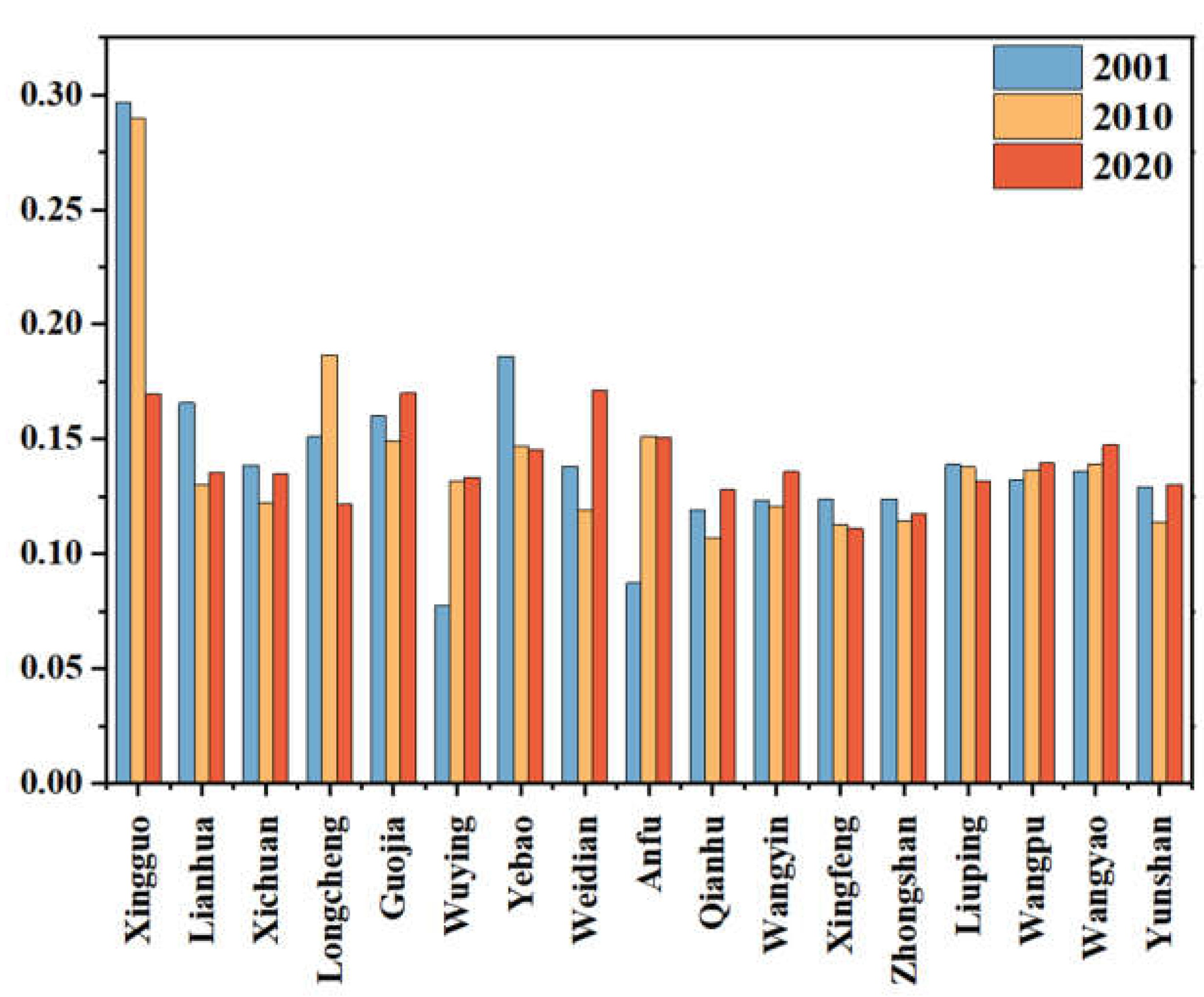
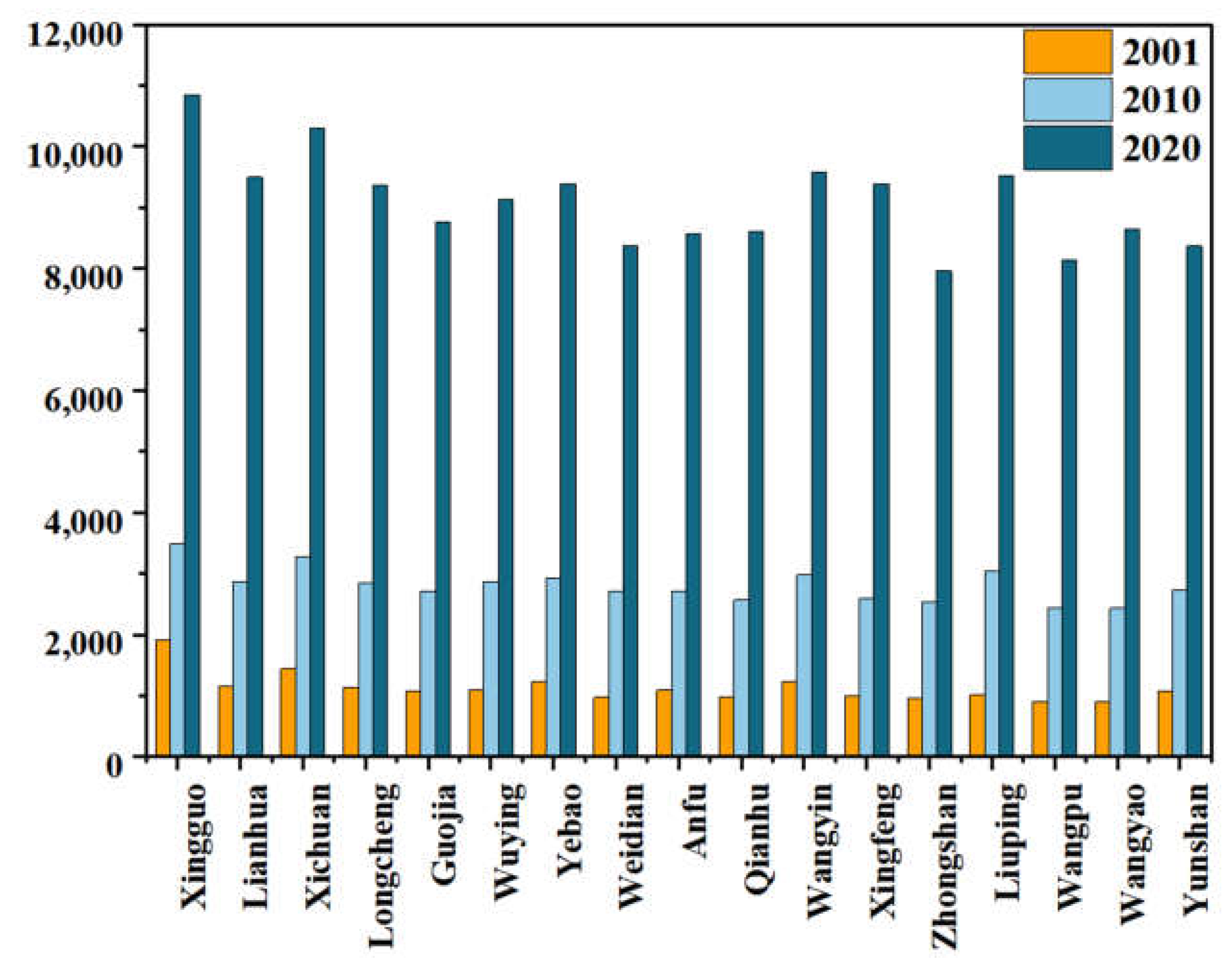

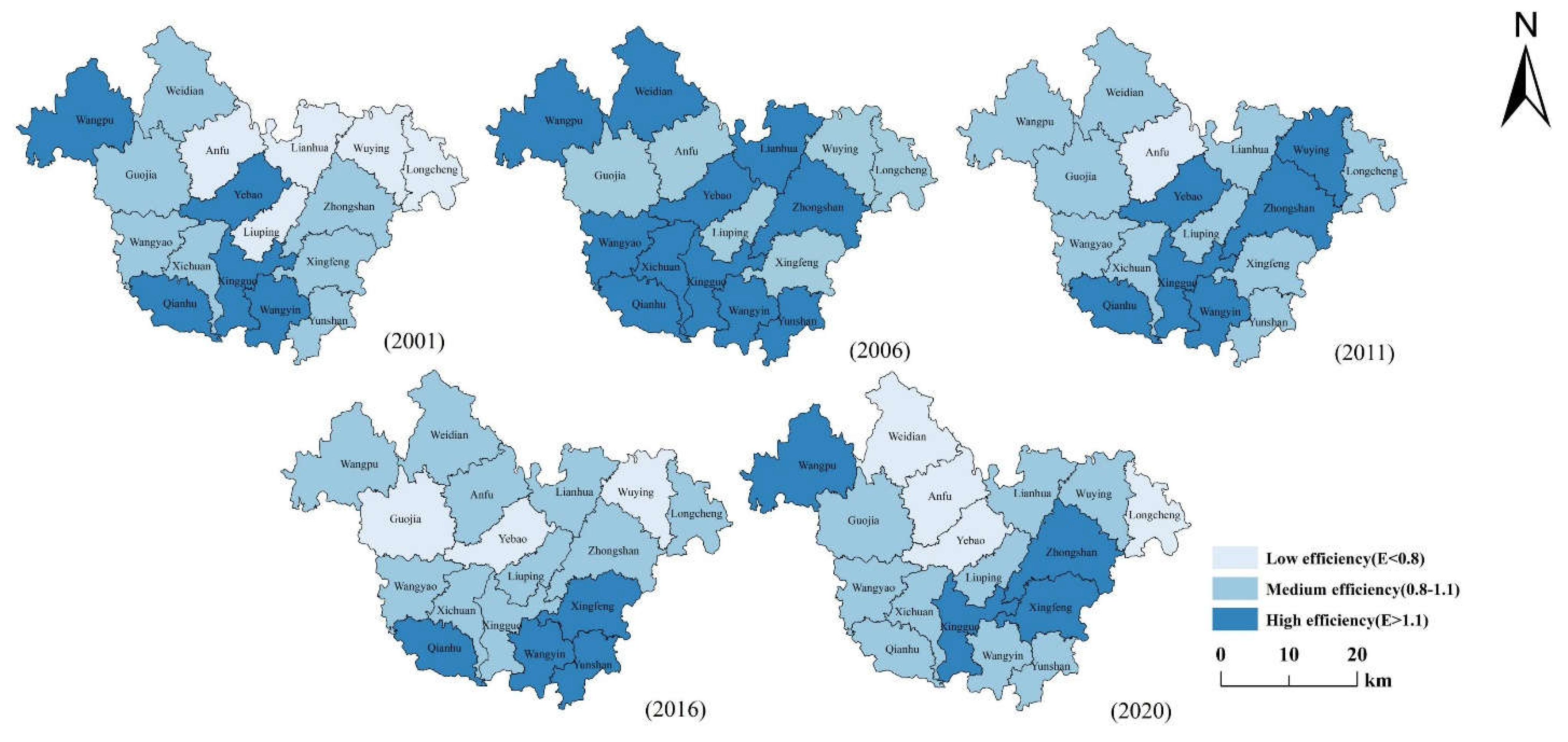
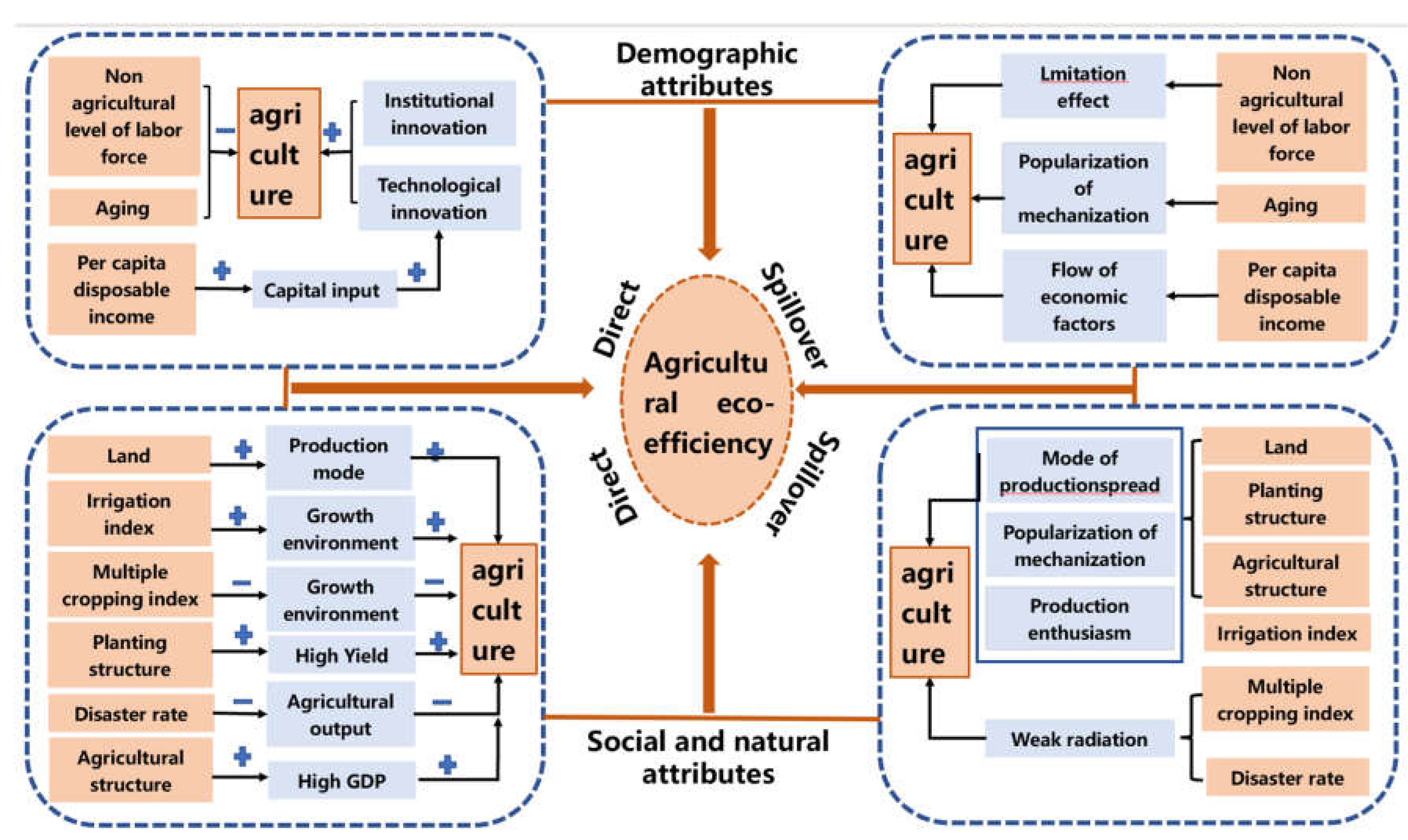
| Indicators | Variables | Variable Description | Units | Mean | Std. Dev. |
|---|---|---|---|---|---|
| Inputs | Land input | Total sown area of crops | 103 ha | 4.2765 | 0.3047 |
| Agricultural labor | Agricultural practitioner | 104 person | 1.1502 | 0.1125 | |
| Mechanical input | Total power of agricultural machinery | 104 kw | 1.2126 | 0.3742 | |
| Fertilizer application amount | 104 tons | 0.3649 | 0.0658 | ||
| Chemical input | Agricultural film application | 104 tons | 0.0079 | 0.0027 | |
| Pesticide usage | 104 tons | 0.0152 | 0.0116 | ||
| Irrigation input | Effective irrigation area | 103 ha | 5.7351 | 1.2070 | |
| Desirable output | Crop yield | Grain crop yield | tons | 10,344.2697 | 2409.5690 |
| Economic crop yield | tons | 27,378.8799 | 13,672.3308 | ||
| Agricultural output value | Total agricultural output value | 108 yuan RMB | 0.8135 | 0.3755 | |
| Undesirable output | Carbon emission | Total carbon emissions from chemical fertilizers, pesticides, agricultural film, agricultural diesel, agricultural irrigation and agricultural sowing | 104 tons | 0.4454 | 0.1212 |
| Variable Types | Variable Name | Variable Description | Mean | Std. Dev. |
|---|---|---|---|---|
| Explained variable | Agricultural eco-efficiency | Super efficiency SBM model calculation | 1.0272 | 0.0954 |
| Explanatory variable | Non-agricultural level of labor force | Non-agricultural employment labor/labor force | 0.3038 | 0.0533 |
| Per capita disposable income | Per capita disposable income | 3905 | 2594 | |
| Aging | The proportion of population 60 and above | 0.1436 | 0.0115 | |
| Control variable | Land | Cultivated land area/total population | 1.9093 | 0.0854 |
| Irrigation index | Effective irrigation area/total area of crop sowing | 0.1147 | 0.0194 | |
| Multiple cropping index | Federation area/crop sowing area | 1.1045 | 0.1737 | |
| Planting structure | Economic crop area/total area of crop sowing | 0.2506 | 0.0178 | |
| Agricultural disaster rate | The area of crop disaster/total sowing area | 0.2846 | 0.0777 | |
| Agricultural structure | Agricultural output value/total output value of agriculture, forestry, animal husbandry, and fishing | 0.8271 | 0.0659 |
| Year | I | p-Value * | Year | I | p-Value * |
|---|---|---|---|---|---|
| 2001 | 0.142 | 0.075 | 2011 | 0.061 | 0.070 |
| 2002 | 0.183 | 0.026 | 2012 | 0.150 | 0.061 |
| 2003 | 0.214 | 0.022 | 2013 | 0.094 | 0.050 |
| 2004 | −0.261 | 0.034 | 2014 | 0.156 | 0.054 |
| 2005 | −0.220 | 0.135 | 2015 | 0.276 | 0.006 |
| 2006 | −0.258 | 0.035 | 2016 | 0.143 | 0.077 |
| 2007 | −0.068 | 0.484 | 2017 | 0.207 | 0.025 |
| 2008 | 0.118 | 0.088 | 2018 | 0.284 | 0.004 |
| 2009 | −0.230 | 0.110 | 2019 | 0.109 | 0.108 |
| 2010 | −0.209 | 0.079 | 2020 | 0.258 | 0.013 |
| Testing Method | Statistics | p-Value | Testing Method | Statistics | p-Value |
|---|---|---|---|---|---|
| LM-spatial lag | 28.620 | 0.000 | Wald-spatial lag | 27.74 | 0.0011 |
| Robust LM-spatial lag | 0.396 | 0.529 | LR-spatial lag | 33.65 | 0.0001 |
| LM-spatial error | 30.401 | 0.000 | Wald-spatial error | 38.54 | 0.0000 |
| Robust LM-spatial error | 2.178 | 0.140 | LR-spatial error | 43.02 | 0.0000 |
| Direct Effect | Indirect Effect | Total Effect | |
|---|---|---|---|
| Non-agricultural level of labor force | 0.1208 * | 0.0494 | 0.1703 |
| (0.0689) | (0.1705) | (0.2069) | |
| Aging | 0.8044 *** | 0.6080 | 1.4124 * |
| (0.2732) | (0.6399) | (0.7925) | |
| Per capita disposable income | 0.0001 *** | 0.0002 *** | 0.0003 *** |
| (0.0002) | (0.0001) | (0.0002) | |
| Land | 0.0174 | 0.0953 ** | 0.1126 ** |
| (0.0219) | (0.0480) | (0.0548) | |
| Irrigation index | 0.0543 | −0.0311 | 0.0233 |
| (0.0570) | (0.1280) | (0.1578) | |
| Multiple cropping index | −0.0461 | −0.4638 | −0.5100 |
| (0.2782) | (0.7350) | (0.8523) | |
| Planting structure | 0.5146 *** | 0.4217 | 0.9363 ** |
| (0.1387) | (0.3678) | (0.4433) | |
| Agricultural disaster rate | −0.1326 ** | −0.0905 | −0.0421 |
| (0.0665) | (0.1571) | (0.1845) | |
| Agricultural structure | 0.3705 *** | 0.0865 | 0.4570 * |
| (0.0669) | (0.2064) | (0.2367) |
Disclaimer/Publisher’s Note: The statements, opinions and data contained in all publications are solely those of the individual author(s) and contributor(s) and not of MDPI and/or the editor(s). MDPI and/or the editor(s) disclaim responsibility for any injury to people or property resulting from any ideas, methods, instructions or products referred to in the content. |
© 2023 by the authors. Licensee MDPI, Basel, Switzerland. This article is an open access article distributed under the terms and conditions of the Creative Commons Attribution (CC BY) license (https://creativecommons.org/licenses/by/4.0/).
Share and Cite
Zong, Y.; Ma, L.; Shi, Z.; Gong, M. Agricultural Eco-Efficiency Response and Its Influencing Factors from the Perspective of Rural Population Outflowing: A Case Study in Qinan County, China. Int. J. Environ. Res. Public Health 2023, 20, 1016. https://doi.org/10.3390/ijerph20021016
Zong Y, Ma L, Shi Z, Gong M. Agricultural Eco-Efficiency Response and Its Influencing Factors from the Perspective of Rural Population Outflowing: A Case Study in Qinan County, China. International Journal of Environmental Research and Public Health. 2023; 20(2):1016. https://doi.org/10.3390/ijerph20021016
Chicago/Turabian StyleZong, Yanling, Libang Ma, Zhihao Shi, and Min Gong. 2023. "Agricultural Eco-Efficiency Response and Its Influencing Factors from the Perspective of Rural Population Outflowing: A Case Study in Qinan County, China" International Journal of Environmental Research and Public Health 20, no. 2: 1016. https://doi.org/10.3390/ijerph20021016
APA StyleZong, Y., Ma, L., Shi, Z., & Gong, M. (2023). Agricultural Eco-Efficiency Response and Its Influencing Factors from the Perspective of Rural Population Outflowing: A Case Study in Qinan County, China. International Journal of Environmental Research and Public Health, 20(2), 1016. https://doi.org/10.3390/ijerph20021016







